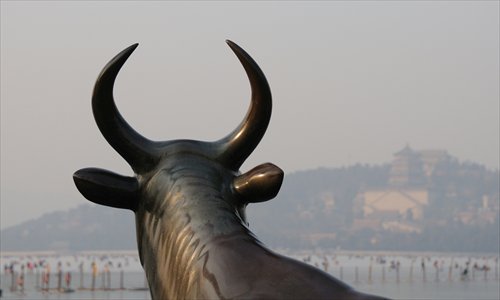Beijing PM2.5 density drops in 2014
2014 reading still 1.5 times higher than national standard

A picture of the Summer Palace on Saturday as Beijing was covered by heavy smog for the last day of the New Year holiday. Photo: CFP

Graphics: GT
Beijing, which is often besieged by smog, saw slightly improved air quality in 2014, recording 204 "good days" and 45 heavily polluted days, the local environmental protection bureau announced Sunday, yet the problem is still grave and requires tougher measures.
The average density of PM2.5, airborne particles smaller than 2.5 microns in diameter and a major air pollutant, dropped by 4 percent from the 2013 level to 85.9 micrograms per cubic meter, Beijing Municipal Environmental Protection Bureau said in a statement.
However, it is still 1.5 times higher than the revised national standard of 35 micrograms per cubic meter that was set in 2012.
Among the 204 good days, 93 were marked "excellent air quality," 22 days more than in 2013. Despite a 22 percent drop, the city saw 45 days of heavy pollution, nearly one-eighth of the year, spread over nine months except June, August and September.
In 2014, Beijing residents suffered seven heavily polluted periods that lasted more than three days, including a weeklong period in February.
The city also witnessed an increase in density of other air pollutants, including nitrogen dioxide and PM10, which grew 1.3 percent and 7.1 percent respectively, said Zhang Dawei, director of the Beijing Municipal Environmental Monitoring Center.
Strong emissions cuts were a major reason for the improvement in 2014, said the bureau. Preliminary data suggests that the city cut emissions of sulfur dioxide and nitrogen oxides by 7,200 and 18,000 tons respectively, both figures a more than 7 percent reduction on 2013.
The achievements were reached through a series of measures. Beijing reduced coal consumption by 2.6 million tons, removed 476,000 outdated vehicles from roads and shut down 375 factories last year.
It also sharply increased air pollutant discharge fees by 14 to 15 times, a pioneering move in the country, according to the statement.
The generally better meteorological conditions in 2014 than 2013 helped with the air quality improvement. But strict control of pollution sources is even more important, as it can be clearly monitored and actively addresses the root of the problem, Zhang Yuanxun, a professor of environmental sciences at the Chinese Academy of Sciences, told the Global Times.
In 2015, Beijing aims to cut the PM2.5 index by 5 percent and reduce emissions of sulfur dioxide and nitrogen oxides by 6 percent from last year, a goal which experts said is reasonable if the new Environmental Protection Law is successfully implemented.
The new law, dubbed the "strictest ever," took effect on the first day of 2015. It imposes unlimited fines for polluting activities and tougher liabilities on violators, law enforcers and local officials.
The law was revised based on China's environmental capacity prospects under an essential economic restructuring phase. Good implementation will bring hope as environmental indices are the indicators of the overall social-economic development status. It is also more cost-effective for society to operate under a legal framework rather than finding solutions after problems occur, said Zhang.
The pollution problems in Beijing and surrounding regions have hampered competitive advantages on the international stage. China should do everything to avoid a tipping point in society caused by the current nationwide pollution, and create a turning point, which means that the government will restore credibility by achieving substantial progress and sustainable solutions, said Arthur Hanson, chief international adviser of the China Council for International Cooperation on Environment and Development.
Regional cooperation, an effective measure that brought blue skies to Beijing during the Asia-Pacific Economic Cooperation summit in November, should be upheld and expanded to wider areas outside the Beijing-Tianjin-Hebei region and further measures such as carbon sequestration are needed to make sure that the pollution is not just blown around, Hanson told the Global Times on Sunday.
Average PM2.5 density should fall by 25 percent from 2012 levels by 2017, according to government plans. Hanson said China should seize the window of opportunity from 2015 to 2030 as efforts peak to control pollution and combat climate change, both domestically and internationally.
Newspaper headline: Beijing PM2.5 density drops